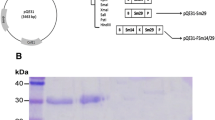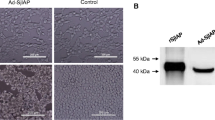Abstract
Schistosomiasis is a worldwide parasitic disease. Currently, chemotherapy is the main effective method to treat schistosomiasis; however, it does not prevent reinfection. No effective vaccine is currently available to prevent schistosomiasis. Sj-F1 (GenBank accession number AY261995) is a novel gene that was discovered through screening adult Schistosoma japonicum worm cDNA library with female S. japonicum antigen-immunized sera. Streptococcus gordonii, a normal inhabitant of the human oral cavity, has been a prime candidate in recent investigations toward developing a live oral vaccine vector. One of the approaches for the surface expression of heterologous antigens in S. gordonii is to surface-localize them with the M6 protein from Streptococcus pyogenes. Here, we develop a recombinant S. gordonii strain that expresses the M6-Sj-F1 fusion protein on the bacterial surface. Intranasal immunization in mice with such M6-Sj-F1-expressing S. gordonii bacteria induced strong serum IgG, serum IgA, and saliva IgA against Sj-F1. The results of protective immunity against a challenge with cercariae of S. japonicum showed statistically significant protection following this treatment, with a worm reduction rate of 21.45 % and an egg reduction rate of 34.77 %. Our data indicate that the described M6-Sj-F1-expressing S. gordonii is highly immunogenic and can partially protect mice from challenge infection with S. japonicum. Intranasal immunization with recombinant S. gordonii may be an alternative to developing a novel S. japonicum vaccine in a safe, effective, and feasible way.




Similar content being viewed by others
References
Caldas IR, Correa-Oliveira R, Colosimo E, Carvalho OS, Massara CL, Colley DG, Gazzinelli G (2000) Susceptibility and resistance to Schistosoma mansoni reinfection: parallel cellular and isotypic immunologic assessment. Am J Trop Med Hyg 62:57–64
Ciabattini A, Giomarelli B, Parigi R, Chiavolini D, Pettini E, Aricò B, Giuliani MM, Santini L, Medaglini D, Pozzi G (2008) Intranasal immunization of mice with recombinant Streptococcus gordonii expressing NadA of Neisseria meningitidis induces systemic bactericidal antibodies and local IgA. Vaccine 26:4244–4250
Ciabattini A, Pettini E, Arsenijevic S, Pozzi G, Medaglini D (2010) Intranasal immunization with vaccine vector Streptococcus gordonii elicits primed CD4+ and CD8+ T cells in the genital and intestinal tracts. Vaccine 28:1226–1233
Giomarelli B, Maggi T, Younson J, Kelly C, Pozzi G (2004) Expression of a functional single-chain Fv antibody on the surface of Streptococcus gordonii. Mol Biotechnol 28:105–112
Gray DJ, Ross AG, Li YS, McManus DP (2011) Diagnosis and management of schistosomiasis. BMJ 342:d2651
Gryseels B, Polman K, Clerinx J, Kestens L (2006) Human schistosomiasis. Lancet 368:1106–1118
Kallestrup P, Zinyama R, Gomo E, Butterworth AE, van Dam GJ, Gerstoft J, Erikstrup C, Ullum H (2006) Schistosomiasis and HIV in rural Zimbabwe: efficacy of treatment of schistosomiasis in individuals with HIV coinfection. Clin Infect Dis 42:1781–1789
King CH, Dangerfield-Cha M (2008) The unacknowledged impact of chronic schistosomiasis. Chronic Illn 4:65–79
Kochi SK, Killeen KP, Ryan US (2003) Advances in the development of bacterial vector technology. Expert Rev Vaccines 2:31–43
Kohama H, Harakuni T, Kikuchi M, Nara T, Takemura Y, Miyata T, Sato Y, Hirayama K, Arakawa T (2010) Intranasal administration of Schistosoma japonicum paramyosin induced robust long-lasting systemic and local antibody as well as delayed-type hypersensitivity responses, but failed to confer protection in a mouse infection model. Jpn J Infect Dis 63:166–172
Lee SF (2003) Oral colonization and immune responses to Streptococcus gordonii: potential use as a vector to induce antibodies against respiratory pathogens. Curr Opin Infect Dis 16:231–235
Li L, Hu X, Wu Z, Wang X, Xu J, Lu F, Yu X (2009) Immunogenicity of self-adjuvanticity oral vaccine candidate based on use of Bacillus subtilis spore displaying Schistosoma japonicum 26 KDa GST protein. Parasitol Res 105:1643–1651
Li R, Lim A, Alonso S (2011) Attenuated Bordetella pertussis BPZE1 as a live vehicle for heterologous vaccine antigens delivery through the nasal route. Bioen Bugs 26:315–319
Mallaley PP, Halperin SA, Morris A, MacMillan A, Lee SF (2006) Expression of a pertussis toxin S1 fragment by inducible promoters in oral Streptococcus and the induction of immune responses during oral colonization in mice. Can J Microbiol 52:436–444
Mayer ML, Phillips CM, Stadnyk AW, Halperin SA, Lee SF (2009a) Synergistic BM-DC activation and immune induction by the oral vaccine vector Streptococcus gordonii and exogenous tumor necrosis factor. Mol Immunol 46:1883–1891
Mayer ML, Phillips CM, Townsend RA, Halperin SA, Lee SF (2009b) Differential activation of dendritic cells by Toll-like receptor agonists isolated from the Gram-positive vaccine vector Streptococcus gordonii. Scand J Immunol 69:351–356
McManus DP, Loukas A (2008) Current status of vaccines for schistosomiasis. Clin Microbiol Rev 21:225–242
Medaglini D, Ciabattini A, Spinosa MR, Maggi T, Marcotte H, Oggioni MR, Pozzi G (2001) Immunization with recombinant Streptococcus gordonii expressing tetanus fragment C confers protection from lethal challenge in mice. Vaccine 19:1931–1939
Oggioni MR, Pozzi G (1996) A host–vector system for heterologous gene expression in Streptococcus gordonii. Gene 169:85–90
Pozzi G, Musmanno RA, Lievens PM, Oggioni MR, Plevani P, Manganelli R (1990) Method and parameters for genetic transformation of Streptococcus sanguis Challis. Res Microbiol 141:659–670
Robert-Guroff M (2007) Replicating and non-replicating viral vectors for vaccine development. Curr Opin Biotechnol 18:546–556
Siddiqui AA, Siddiqui BA, Ganley-Leal L (2011) Schistosomiasis vaccines. Hum Vaccin 7:1192–1197
Steinmann P, Keiser J, Bos R, Tanner M, Utzinger J (2006) Schistosomiasis and water resources development: systematic review, meta-analysis, and estimates of people at risk. Lancet Infect Dis 6:411–425
Acknowledgments
This work was supported by the Major Program of Natural Science Foundation of Hunan Province, People’s Republic of China (no. 10JJ2012).
Author information
Authors and Affiliations
Corresponding author
Rights and permissions
About this article
Cite this article
Wang, L., Liu, W., Yang, M. et al. Development of a Streptococcus gordonii vaccine strain expressing Schistosoma japonicum Sj-F1 and evaluation of using this strain for intranasal immunization in mice. Parasitol Res 112, 1701–1708 (2013). https://doi.org/10.1007/s00436-013-3327-1
Received:
Accepted:
Published:
Issue Date:
DOI: https://doi.org/10.1007/s00436-013-3327-1




